#grindadráp
Text
Exploring the Rich Tapestry of the Faroe Islands History, Culture, and Weather

Nestled in the North Atlantic Ocean between Norway, Iceland, and Scotland, the Faroe Islands constitute an archipelago of stunning natural beauty and captivating history. These remote islands, characterized by dramatic cliffs, lush green valleys, and picturesque villages, have a unique cultural heritage shaped by their Norse origins, rugged terrain, and maritime traditions. In this article, we delve into the fascinating history, vibrant culture, and ever-changing weather that define the Faroe Islands.
History:
The history of the Faroe Islands dates back over a millennium, with evidence of human settlement dating as far back as the 6th century AD. Originally inhabited by Gaelic monks, the islands were later colonized by Norse settlers from Norway in the 9th century. These settlers established a distinct Norse culture and language that still prevails today.
Throughout the centuries, the Faroe Islands were subject to various external influences, including domination by the Kingdom of Norway, followed by the Kalmar Union with Denmark in the 14th century. In the aftermath of the Protestant Reformation, the islands came under Danish control and remained so for several centuries.
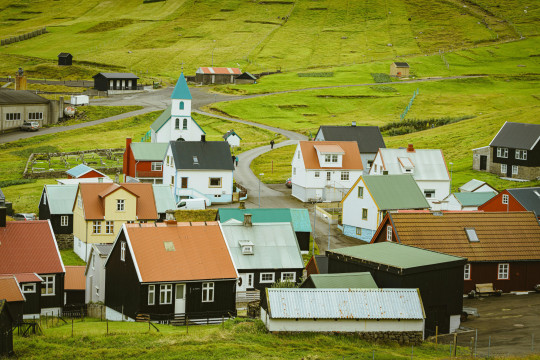
In the 20th century, the Faroe Islands gradually gained greater autonomy within the Kingdom of Denmark, culminating in the establishment of Home Rule in 1948. Today, the Faroese people govern their internal affairs, including cultural and economic matters, while Denmark retains responsibility for foreign affairs and defense.
Culture:
The culture of the Faroe Islands is deeply rooted in Norse traditions, with a strong emphasis on community, storytelling, and the sea. The Faroese language, closely related to Icelandic and Old Norse, is the official language and serves as a symbol of cultural identity.
Music and dance play an integral role in Faroese culture, with traditional folk songs known as kvæði and chain dancing still practiced during festivals and celebrations. The islands also have a thriving contemporary music scene, with local bands gaining international recognition for their unique blend of traditional and modern influences.
Fishing has been a cornerstone of the Faroese economy and culture for centuries, shaping the way of life and providing sustenance to the islanders. The annual Grindadráp, or pilot whale hunt, is a controversial tradition that continues to divide opinions both locally and internationally, reflecting the complex relationship between tradition, sustainability, and modern values.
Despite its remote location, the Faroe Islands have embraced modern technology and innovation while maintaining a strong connection to their cultural heritage. This blend of tradition and progress is evident in everything from architecture and design to cuisine and literature, making the islands a dynamic and intriguing destination for visitors.
Weather:
The Faroe Islands' weather is characterized by its maritime climate, with mild winters, cool summers, and frequent precipitation throughout the year. The islands are often shrouded in mist and fog, lending an ethereal atmosphere to the rugged landscapes.
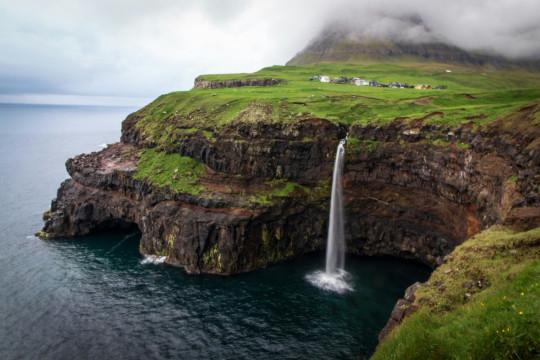
Due to their location in the North Atlantic, the Faroe Islands are subject to rapid weather changes, with sunny spells giving way to sudden squalls and shifting winds. This unpredictable weather adds to the island's allure but also presents challenges for residents and visitors alike, requiring preparedness and flexibility when exploring the outdoors.
Despite the ever-changing weather, the Faroe Islands offer a wealth of outdoor activities, from hiking and birdwatching to sea angling and kayaking. Each season brings its own unique charms, whether it's the vibrant colors of spring, the endless daylight of summer, or the dramatic storms of winter.
In conclusion, the Faroe Islands stand as a testament to the resilience of a people shaped by their environment, history, and cultural heritage. With its captivating landscapes, rich traditions, and dynamic climate, this remote archipelago continues to enchant and inspire all who venture to its shores.
2 notes
·
View notes
Text
Cold, Remote and Short of Women: A Portrait of Life on the Faroe Islands
— March 23, 2023 | By Oscar Holland

Aadne and Jóannes, 51-year-old twin brothers in the Faroe Islands, which has 107 men for every 100 women. "I pray to God that I will find a wife," Jóannes told photographer Andrea Gjestvang. "But maybe he doesn't hear me."Scroll through the gallery to see more images from Gjestvang's book "Atlantic Cowboy." Andrea Gjestvang/GOST Books
In her striking images of the Faroe Islands, a remote archipelago between Iceland and her native Norway, photographer Andrea Gjestvang depicts islanders and livelihoods that are as tough and unforgiving as the windswept landscape.
Fishing trawlers travel through frigid seas. Clouds roll over craggy mountains and cliffside villages. Clothes and boots are stained with the blood of slaughtered livestock and marine animals. Well-used tools hang from the walls of traditional wooden buildings.
The innate connection between Faroese people and their surroundings is woven through Gjestvang's new book about the islands, "Atlantic Cowboy." Portraits appear alongside dramatic landscape shots that reiterate the Faroes' harsh conditions and remoteness of settlements dwarfed by neighboring mountains.
"I'm not a landscape photographer but, just like when I portray people, when I photograph a landscape, I look for mood," Gjestvang said during a video interview. "I try to think about the landscape as also kind of a portrait, or something that express feelings, somehow."
Gjestvang's photos also reveal another challenging aspect of life in the Faroes, which may have been first inhabited by Irish monks in the 6th century: Her subjects are almost exclusively male.
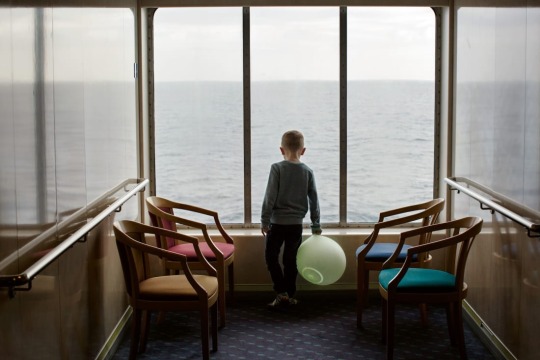
A young boy on a ferry traveling from the Faroe Islands' capital, Tórshavn, to the archipelago's southernmost island, Suduroy. Andrea Gjestvang/GOST Books
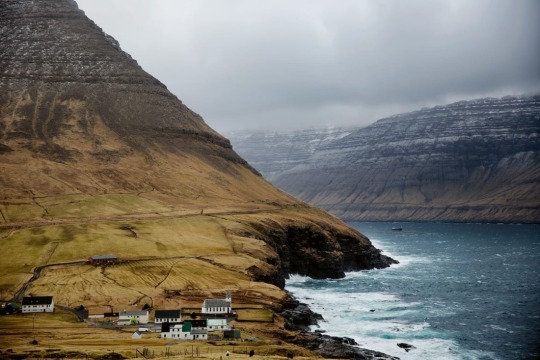
Gjestvang also captured the rugged geography of the Faroe Islands. "When I photograph a landscape, I look for mood," she said. "I try to think about the landscape as also kind of a portrait, or something that expresses feelings, somehow." Andrea Gjestvang/GOST Books
Though much of the Faroese economy revolves around physically demanding jobs traditionally taken by men — the islands' fishing industry alone employs 15% of the workforce. Visiting several times annually over the course of six years, Gjestvang trained her lens on the lives and communities of the islands' unmarried men. They are shown plucking seabirds' feathers, tending to goats or hauling the carcasses of a slaughtered pilot whales to shore. (Whale meat was once an important part of the Faroese diet, though the nation's controversial whale and dolphin hunts now spark global outrage.)
Young women, meanwhile, often choose to study or work in Copenhagen (the Faroe Islands are part of the Kingdom of Denmark) or elsewhere in Europe. Many never return, Gjestvang learned. According to World Bank data, just 48.2% of the self-governing nation's population in 2021 was female, putting it among the most gender-imbalanced places in Europe. This equates to over 107 men for every 100 women, or a deficit of roughly 2,000 females.

Faroe Islander Fróði rests on the carcass of a pilot whale after a "grindadráp," or whale hunt, a controversial tradition that often sparks global outrage. Andrea Gjestvang/GOST Books

Rogni and Odin, aged 26 and 25 respectively, are among only a handful of people living in Mykines, the Faroes' westernmost island. Andrea Gjestvang/GOST Books
This number may not seem huge, but with the 17 inhabited islands only home to around 53,000 people — and the gender gap more pronounced among younger adults — it poses significant societal implications. Faroese Prime Minister Aksel V. Johannesen said "skewed gender demographics" were among his government's "greatest challenges" upon first taking office in 2015.
For Gjestvang, this dynamic offered an "an interesting opportunity to do a project on men," she said. "As a female photographer, I get commissioned a lot to do women's health stories, and women's issues — which are very important — but I was curious to turn my camera in a different direction."

A carpentry workshop in the capital Tórshavn. Andrea Gjestvang/GOST Books

Faroe Islander Hjalmar is pictured while slaughtering sheep on a farm in the village of Kaldbaksbotnur. Andrea Gjestvang/GOST Books
Evolving Masculinity
Economic prospects for Faroese women now look rosier than in the 1990s, when thousands of people left the amid an economic collapse caused, in part, by shrinking fish stocks. Boosted by a growing tourism and service sectors, the GDP per capita has tripled since 2000 and is now on par with that of the United States.
The nation's government has in recent years invested in gender equality and employment initiatives in the hope of making the islands more appealing to women. "They have tried to make it slightly easier to be a single mother," Gjestvang added, citing expanded offerings at the capital's university and increased acceptance of remote working due to the Covid-19 pandemic.
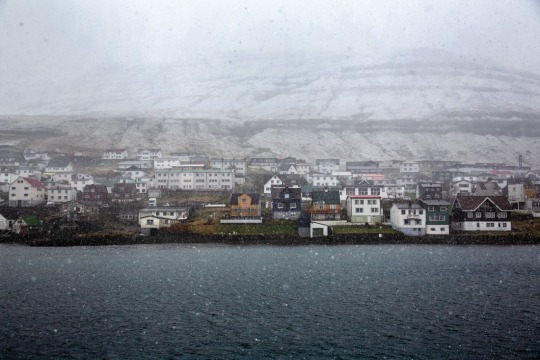
The Faroe Islands' second-largest town, Klaksvík. Andrea Gjestvang/GOST Books

One of Gjestvang's subjects, 54-year-old Andrias, is pictured with his kitten outside his home in Vidareidi. He studied in Denmark before returning to the Faroe Islands and buying a boat. Andrea Gjestvang/GOST Books
The photographer said the lack of women was not evident in the Faroese capital, Tórshavn, though it became "quite visible" when traveling to smaller villages. The social lives of these coastal communities often revolve around harbors, and she spent time visiting the informal meeting places where men "hang out, have beers and talk."
But Gjestvang's sensitive portraits also offer a candid snapshot of men in their own homes. Several are captured sitting or lying alone on sofas, while others are pictured with pets or female relatives. In accompanying interviews, some of which in her book, her subjects opened up about the realities of life in a male-dominated society. "I pray to God that I will find a wife," one unmarried man told her. "But maybe he doesn't hear me."
The photographer believes, however, that most of the men she documented were not lonely — thanks, in part, to the close-knit nature of Faroese families. As one 40-year-old told her: "Strong family ties become a substitute. I already have a family myself, even though I don't have a wife and children. When you have an extended, close-knit family, you have the freedom to be yourself and find peace with that."
"One man I interviewed told me that the Faroe Islands is the perfect playground for men," the photographer added, explaining her book's title. ("Atlantic Cowboy" is a term borrowed from a 1997 book of the same name and later used by Firouz Gaini, a professor of anthropology at the University of the Faroe Islands who has studied the nation's gender dynamics and wrote a foreword for Gjestvang.)
"It's a place where you can and fish and be outdoors and the freedom is endless, somehow," Gjestvang said.
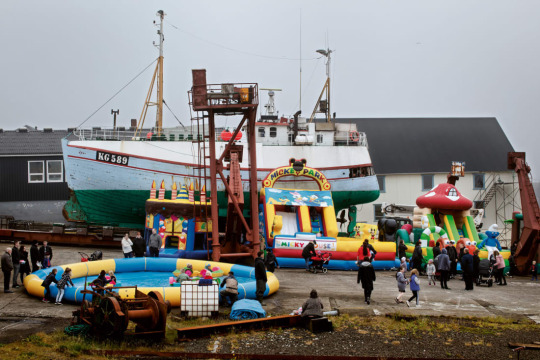
A temporary amusement park in the town of Vágur. Andrea Gjestvang/Andrea Gjestvang
Decades of lop-sided demographics have meanwhile contributed to a national identity that continues to celebrate virtues of strength and fortitude, the photographer added.
"To be strong, and to provide for yourself and your family has been an important value," she said. "The idea of the strong man is very present, and you can see it ... This kind of masculinity has gained a lot of respect, and has been sought-after.
"I think this has, of course, affected society, even though I will say that Faroese women are also very strong — they are tough, too."
2 notes
·
View notes
Text
Mattanza dei delfini: scempio ambientale e sociale
La mattanza dei delfini è una di quelle pratiche marine che oltre ad avere pesanti risvolti ecologici rappresenta anche un pugno nello stomaco delle coscienze. Le immagini scioccanti di acque rosse di sangue e delfini inermi suscitano ogni volta indignazione e sconcerto in tutto il mondo. Sono figlie di lunghissime tradizioni che mal si conciliano con le consapevolezze etiche e ambientali dei nostri tempi.
La mattanza dei delfini: una crudele tradizione
La mattanza dei delfini, chiamata anche "grindadráp" nelle Isole Fær Øer e "taiji" in Giappone, è una tradizione controversa che coinvolge la cattura e il massacro di delfini per scopi alimentari o culturali. Questa pratica, che coinvolge spesso intere famiglie di delfini, è un processo crudele e spesso inumano, sollevando domande sull'etica e la sostenibilità di tali azioni.
Questa antica tradizione ha un impatto significativo sull'ecosistema marino. I delfini giocano un ruolo chiave nell'equilibrio degli oceani, aiutando a controllare le popolazioni di pesci e contribuendo alla biodiversità marina. La cattura e l'uccisione indiscriminata di delfini possono destabilizzare questi delicati equilibri, causando impatti a catena sulla fauna e sulla flora marina.
Questioni etiche e morali
Uno dei punti centrali della controversia riguarda le questioni etiche e morali legate alla mattanza dei delfini. Molti attivisti e organizzazioni per la protezione degli animali stanno adottando questa pratica come una forma di crudeltà e maltrattamento verso creature intelligenti e sensibili. In un'epoca in cui la consapevolezza dell'importanza della tutela degli animali sta crescendo, la mattanza dei delfini solleva interrogativi sulla nostra responsabilità di trattare tutte le forme di vita con rispetto.
In alcune comunità, la mattanza dei delfini è radicata in tradizioni culturali e storiche. Ad esempio, nelle Isole Fær Øer, questa pratica è stata eseguita da secoli e ha una connessione profonda con la cultura locale. Tuttavia, le implicazioni culturali non dovrebbero ignorare i crescenti problemi di sostenibilità e le conseguenze per l'ambiente marino. Trovare un equilibrio tra il rispetto per la tradizione e la protezione dell'ecosistema marino è una sfida complessa.
La necessità di alternative sostenibili
Un approccio fondamentale per affrontare la mattanza dei delfini è cercare alternative sostenibili e rispettose dell'ambiente. L'educazione e la sensibilizzazione possono svolgere un ruolo chiave nel promuovere la comprensione dell'importanza dei delfini nell'ecosistema marino. Inoltre, lo sviluppo di tecniche di pesca sostenibili e pratiche etiche può contribuire a ridurre l'impatto negativo sulla vita marina.
La mattanza dei delfini solleva domande che vanno al di là dell'ambiente marino. Rappresenta una riflessione su come l'umanità si relaziona con il mondo naturale e con altre forme di vita che condividono il pianeta con noi. È un richiamo a considerare le nostre azioni e le loro conseguenze, cercando un equilibrio tra tradizioni culturali, sostenibilità e rispetto per la vita marina.
In copertina foto di Ildigo da Pixabay
Read the full article
0 notes
Text
Kreuzfahrtpassagiere werden Zeugen einer brutalen Wal-Treibjagd
Waljagd Färöer Inseln …
Schockierende Szenen auf den Färöer-Inseln
Etwa 1000 Passagiere der Ambassador Cruise Lines wurden unfreiwillige Zeugen einer brutalen Wal-Treibjagd auf den Färöer-Inseln, als ihr Kreuzfahrtschiff im Hafen von Torshavn eintraf. Mehr als 40 Grindwale wurden bei der sogenannten Grindadráp – einer umstrittenen Tradition der Inseln – abgeschlachtet.
Die Inselgruppe,…

View On WordPress
1 note
·
View note
Text
Over 500 dolphins killed in Faroe Islands since hunt resumed in May
The Guardian
By Agence France-Presse in Copenhagen
Thu 15 Jun 2023 10.37 EDT
The Faroe Islands has killed more than 500 dolphins since its hunt resumed in May, according to local authorities in the autonomous Danish territory in the north Atlantic.
In the Faroese tradition known as grindadráp, or grind for short, hunters surround pilot whales and dolphins with a wide semi-circle of fishing…
View On WordPress
0 notes
Text
FAROE ISLANDS: Hundreds of pilot whales killed in Faroe Islands annual hunt [GRAPHIC]
Hundreds of pilot whales were killed in a controversial whale hunt in the Faroe Islands on June 14.
Grindadráp is an ancient Faroese tradition, with locals carrying out hunts for centuries to kill pilot whales for their meat and fat, a vital food source that will help feed the 50,000 islanders through the winter.
The marine conservation group Sea Shepherd, which campaigns against the Faroese…

View On WordPress
0 notes
Photo

I'm back. A test to see if it works out/Kim #Repost @teamwatsonsanfrancisco —— Posted @withregram • @seashepherduk The relentless hunt of The Long Finned Pilot Whale ⚠️ In the Faroe Islands, annual drive hunts known as "grindadráp" result in mass slaughter. We receive countless responses to these shocking images questioning what could possibly justify this murder? As a food source? Consuming Pilot whales is not only inexcusably immoral but severely harmful. As discussed at The North Atlantic Marine Mammal Commission's 2022 Meeting, most Cetaceans contain toxic levels of Mercury and are scientifically not recommended for human consumption. So why? Why would anyone continue such a barbaric event ? The Faroese state they must “maintain the killing of hundreds of pilot whales each year to maintain community cohesion” Maintain a merciless tradition or an entire species population? We need you to take action and stand united against this continuous atrocity ✊ We will not stop until we end this mindless slaughter. Share this post to help #stopthegrind #SeaShepherd #grindadrap #pilotwhales #faroeislands #SeaShepherdUK #HighSeas #Nature #Conservation #stopthismadness (at Faroe Islands) https://www.instagram.com/p/Cpu1p-GIg0-/?igshid=NGJjMDIxMWI=
#repost#stopthegrind#seashepherd#grindadrap#pilotwhales#faroeislands#seashepherduk#highseas#nature#conservation#stopthismadness
0 notes
Text
Faroe Islands will allow 500 dolphins to be killed in annual whale hunt
Faroe Islands will allow 500 dolphins to be killed in annual whale hunt
Situated halfway between Iceland and Scotland in the Atlantic Ocean, the Faroes are a self-governing territory of the Kingdom of Denmark made up of 18 islands.
The yearly whale cull, or grindadráp in Faroese, is a traditional practice that dates back to the first settlement of the islands by Vikings in 800 CE.
Animal rights organizations have historically condemned the cull, in which whales are…
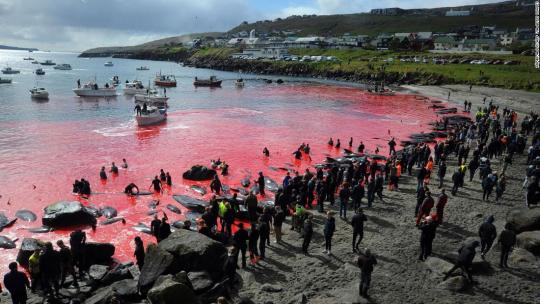
View On WordPress
0 notes
Text
Faroe Islands will allow 500 dolphins to be killed in annual whale hunt
Faroe Islands will allow 500 dolphins to be killed in annual whale hunt
Situated halfway between Iceland and Scotland in the Atlantic Ocean, the Faroes are a self-governing territory of the Kingdom of Denmark made up of 18 islands.
The yearly whale cull, or grindadráp in Faroese, is a traditional practice that dates back to the first settlement of the islands by Vikings in 800 CE.
Animal rights organizations have historically condemned the cull, in which whales are…

View On WordPress
0 notes
Photo
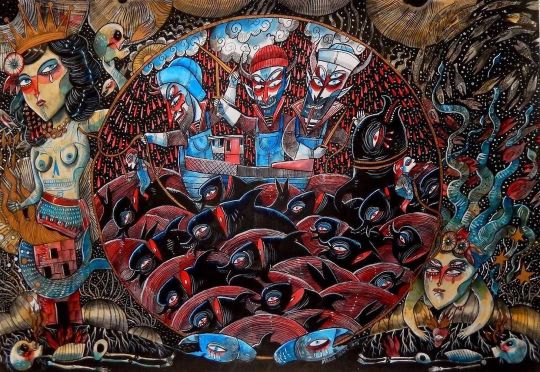
This one is gone. It’s about those terrible #grindadráp which happens every year on Faroe Islands. When I’ve showed it for the first time someone tell me it’s a customs, so how can we do for change it. Every customs even very old one can evolve with times. This whales hunt had a reason a long time ago : feed Faroe people. But now it’s useless and just become a bloody folklore. Why don’t transform it in a festival to thanks whales for all those centuries in which they were the main food source and their sacrifice help people on the islands ? It will be beautiful to reconnect in a other way with tradition without blood and hunt. Without cruelty. Perhaps it’s time for humans to be grateful with nature, not always hurtful. Just my feelings. . . . . . #grindadrap #dolphins #whales #hunt #globicephalamelas #bekind #sea #ocean #deepsea #faroeislands #faroe #denmark #whaleshunting #outsiderart #minamond #naifnoir https://www.instagram.com/p/CO6fTBGAacV/?igshid=1s5y0rzskv9yi
#grindadráp#grindadrap#dolphins#whales#hunt#globicephalamelas#bekind#sea#ocean#deepsea#faroeislands#faroe#denmark#whaleshunting#outsiderart#minamond#naifnoir
8 notes
·
View notes
Text
unpopular opinion: there is nothing wrong with grindadráp and calling it savagery is wrong if not just racist.
2 notes
·
View notes
Text
Matanza de Delfines en las Islas Feroe
DIBUJO: Matanza de Delfines en las Islas Feroe
Un macabro espectáculo en aras de la tradición
#grandadrap #delfines #matanzadelfines #calderones #ballenas #caza #islasferoe #dinamarca #comic #tebeos #menorca #drawing #caricatura #cartoon #art #dibujos
(© Julia) Matanza de más de 1.400 DELFINES en el transcurso de una “caza tradicional” que se viene llevando a cabo en las Islas Feroe, Dinamarca, durante siglos, el llamado Grindadráp. ¡Un macabro espectáculo en aras de la tradición!
Normalmente matan “ballenas piloto” o “calderones” en su mayoría, pero este año les ha tocado a los “delfines de flancos blancos”.
Teniendo en cuenta la alta calidad…

View On WordPress
#ballenas piloto#BOCETO#bosquejo#calderones#caza tradicional#croquis#dibujo#esbozo#esquema#Flancos Blancos#Grindadráp#ilustración#Islas Feroe#Matanza Delfines#Menorca#PINTURA#retrato#rincón julia#viñeta
0 notes
Photo

Please Sign this Shit if you have t already! Stop The Cruel Dolphin Hunt in the Faroe Islands. https://only.one/act/dolphinhunt @paulnicklen #repost “Please comment with a 💔 if you find these images of slaughtered white-sided dolphins as horrific as I do. They are the victims of a traditional dolphin hunt called Grindadráp (or "The Grind") that takes place annually on the shores of the Faroe Islands, an archipelago between Iceland and Norway. Last week's horrific event is estimated to be the largest single cull in the island's history, with even seasoned whalers deeming the slow, cruel mass killing of over 1,400 white-sided dolphins in a single day unethical. I don't believe "tradition" is an adequate justification for this senseless practice. In fact, I can't think of a single reason why it should be allowed to continue. If you agree, please visit the link in my bio and sign our @OnlyOne petition urging the Faroese Prime Minister to end the Grindadráp for good. With @SeaLegacy. Photos by @SeaShepherd. #Dolphin #WhiteSidedDolphin #FaroeIslands #Faroe #Slaughter #VisitFaroeIslands #ForTheOcean #SaveTheOcean #MarineConservation #OnlyOne (at Faroe Islands) https://www.instagram.com/p/CUM90prgoGk/?utm_medium=tumblr
#repost#dolphin#whitesideddolphin#faroeislands#faroe#slaughter#visitfaroeislands#fortheocean#savetheocean#marineconservation#onlyone
60 notes
·
View notes
Photo



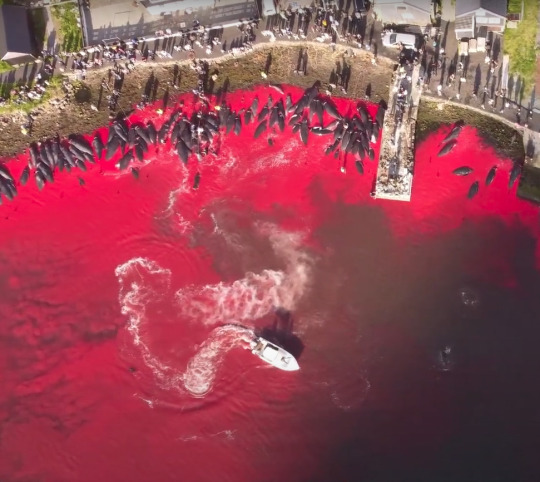

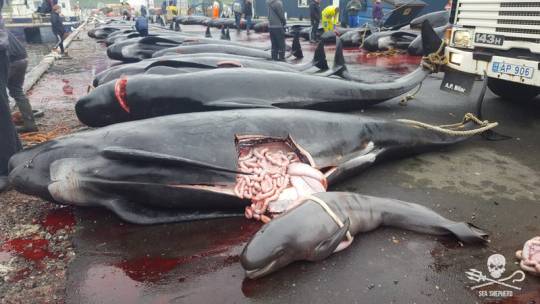
‘TRADITIONAL TORTURE’ at Faroe Islands !
“Grindadráp” (Lattice Killing) for the locals...
The island is so popular that it closed itself to tourists, except those who are willing to help repair and maintain the island. However, there is a darker side.
Almost 1,500 cetaceans (dolphins and whales) were killed last Sunday (with also pregnant whales)
“This is, we believe, the largest ever single hunt of dolphins or pilot whales in Faroese history — the next largest being 1,200 pilot whales back in 1940 — and is possibly the largest single hunt of cetaceans ever recorded worldwide.
Sea Shepherd
The Faroe Islands are formally part of the Kingdom of Denmark, but have significant autonomy.
EU law bans "deliberate capture or killing" of any dolphins or whales, but since the Faroe Islands are not part of the union they do not have to abide by the rules.
The barbaric fishing process involves boats heading out to find pods of whales and dolphins, and rounding them up into shallow waters. They struggled for breath on the beach until they are killed.
The Faroese insist that this meat is not sold, but every part of the whale is used and is shared amongst their community as a valuable source of meat for a region that has very little in terms of natural resources. The whole of that statement is a lie for four reasons:
Whale meat from the grinds is sold in supermarkets and restaurants in the Faroe Islands, so it is bringing in money for some of the people involved which makes it a commercial enterprise.
Every part of the whale killed is not used, not even every whale killed is used. The hunters have been documented discarding whole whale carcasses into the sea that they did not have time to process before dusk.
It is not a valuable source of meat, it is very dangerous due to the amount of toxins (high levels of mercury and PCBs) even Faroese doctors confirm it contains. The poisonous levels would not be legal in any other food approved for human consumption and the fact that children are being given this meat to eat by parents who should know better means that they are being poisoned. There is a high incident of disease on the island related to these pollutants.
The Faroe Islands have a thriving fishing industry including farmed salmon. They also have a large amount of sheep. They trade these commodities for all the benefits of a materialisic society and with this and their subsidies they enjoy one of the highest standards of living in the world.
Millie Hall of East Yorkshire
Photographs: Sea Shepherd, Richard Smith / Sygma
#massacre#killing#dolphins#whales#pregnant#sustainability#murderer#faroe islands#sea shepherd#millie hall#ecology#toxic traits#mercuryicon#PCBs#poison#hunt#torture#commercial#sygma#richard smith#barbaric#barbarian#grindadrap#Consumerism
20 notes
·
View notes
Text
Faroe Islands: Northeast Atlantic area

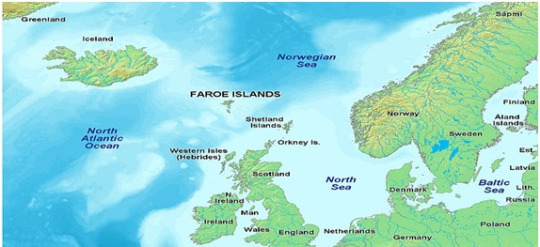
In news:
Recently, public health authorities of the Danish Autonomous North Atlantic Area have warned that the pilot whale found in the Faroe Islands could produce a serious threat to human health.
It is notable that pilot whales are hunted during an annual program on the Faroe Islands, which is called Grindadráp .
Even here the law has recognized this annual practice of killing the pilot whale,…
View On WordPress
0 notes
Photo

Sea Shepherd : l’ultimo baluardo a difesa della vita negli oceani La Sea Shepherd Conservation Society è un’organizzazione no-profit che si occupa della conservazione marina ed è registrata negli Stati Uniti.
#Ambiente#biodiversità#AmbienteBio#Sea Shepherd#caccia alle balene#Grindadráp#Isole Faroe#mattanza balene#Ambiente Bio
0 notes